Brown spiders are common in North America. Light or dark brown spiders can be found in multiple species such as orbweavers or recluse spiders.
Spiders can have partial brown colors such as marks on the abdomen or the head. Some spiders only have brown legs. Other spiders are completely brown.
Coloring differences might also be seen between male and female spiders.
Most frequently, brown spiders in North America have a brown pattern with a combination of light and dark brown colors.
Table of Contents
Are Brown Spiders Venomous?
Most brown spiders in the US aren’t venomous. They spin spider webs and they eat insects caught in these spider webs.
Other brown spiders use ambushing techniques that don’t require building a spider web.
A smaller percentage of brown spiders in the US are venomous. Their venom is highly dangerous, however.
Necrotic venom is found in brown spiders such as the Brown Recluse. This type of venom can require medical attention when bitten.
Types of Brown Spiders
The following brown spiders are venomous or non-venomous and found in North America.
1. Spotted Orbweaver
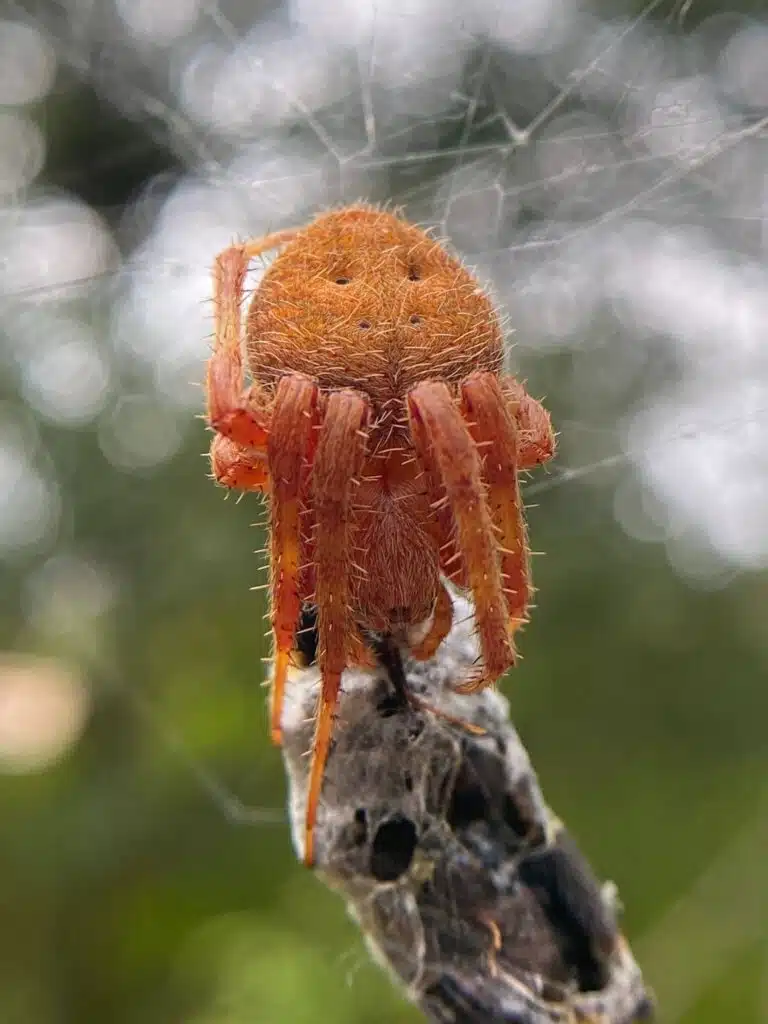
Scientific name: Neoscona crucifera
Common name: Spotted orbweaver, barn spider, Hentz orbweaver
Spotted Orweavers are one of the most common brown spiders in the US. This species might be nocturnal but its high population makes it a common sight across multiple states.
One of the reasons this nocturnal brown species is such a common sight is a change in its behavior in the fall.
Spotted Orbweavers are nocturnal brown spiders that turn diurnal in the fall.
Physical differences exist between males and females. The female Spotted Orbweaver is larger, growing to a size of up to 19mm.
Both males and females have a brown body with dark brown marks on the abdomen and the legs.
The species builds an orb-shaped spider web, often connected to man-made structures such as homes.
2. American Nursery Web Spider
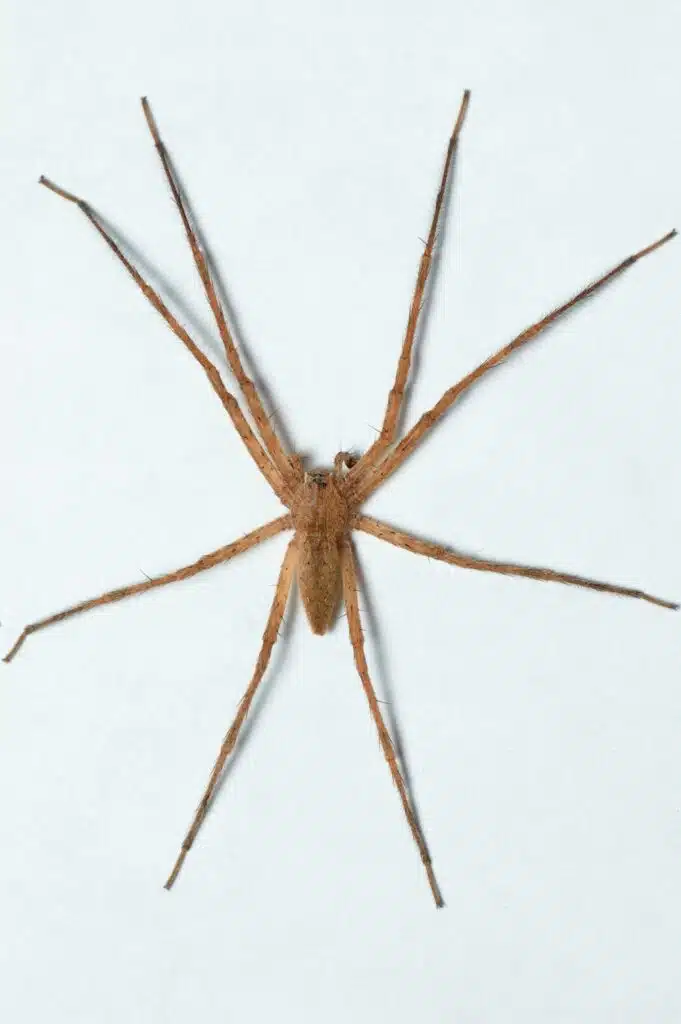
Scientific name: Pisaurina mira
Common name: American nursery web spider
American Nursery Web spiders have a yellow or yellow-brown color. This color is dominant on its body and legs.
Some American Nursery Web spiders might also have a dark brown band that runs across the mid-section of their bodies.
These spiders grow to an average size between 12 and 15 mm and are known as ambush predators.
American Nursery Web spiders don’t build spider webs. These spiders hunt prey and even large insects.
Some data suggests American Nursery Web spiders are good ambush predators making the most of their brown color to blend in with their surroundings.
3. Dark Fishing Spider
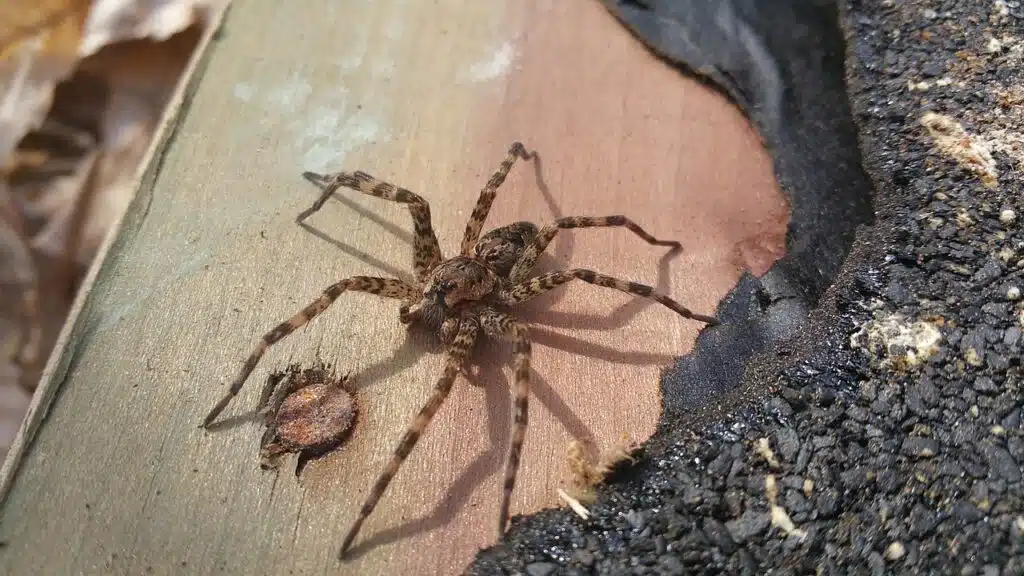
Scientific name: Dolomedes tenebrosus
Common name: Dark fishing spider
The Dark Fishing spider is one of the largest dominantly-brown spiders.
It has a mottled brown and black color.
Some spiders of this family also have white marks, but these are small by comparison with other large dark marks on its body.
Spiders of this genus have good vision and pounce on prey instead of building spider webs.
Male Dark Fishing spiders live short lives compared to females.
The male spider dies immediately after mating with the female.
The female then proceeds to eat the male. This means the male Dark Fishing spider can only mate once and that the female benefits nutritionally from the male after reproduction.
4. Brown Recluse
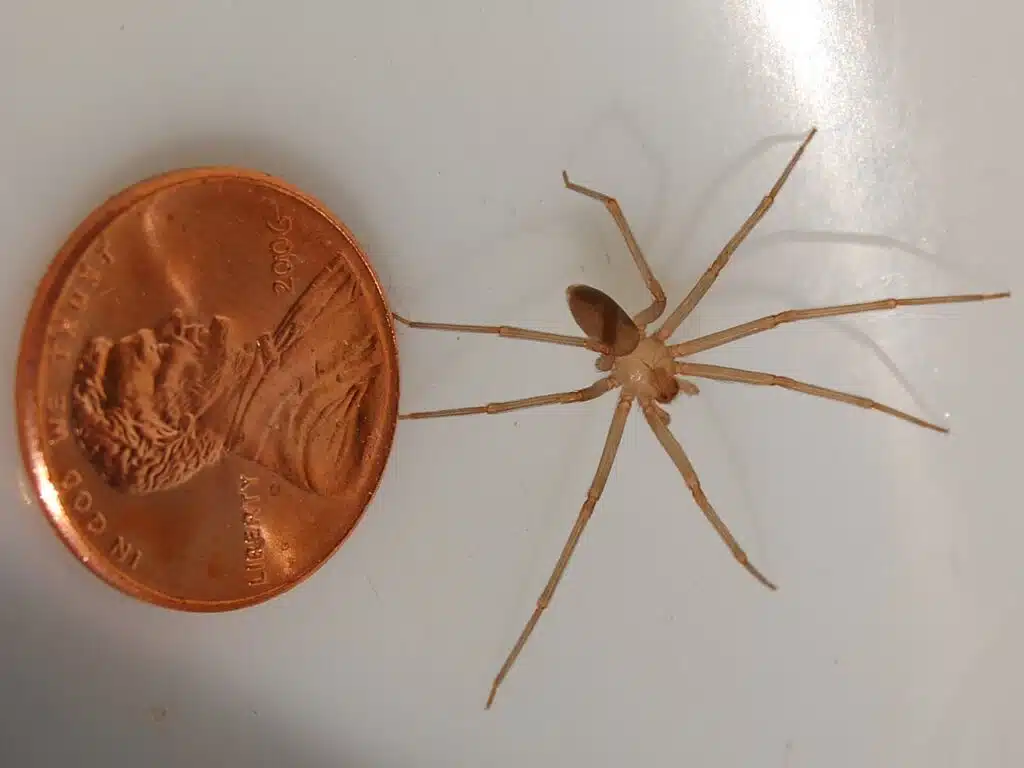
Scientific name: Loxosceles reclusa
Common name: Brown recluse
The Brown Recluse is one of the few spiders with a medically significant venom in the US.
This species has a necrotic venom which means medical attention is required after a bite.
Brown Recluse spiders are common in the Southeast. This highly venomous spider isn’t present on the West Coast.
Brown Recluse spiders get their names from their light brown color. Some spiders of this genus have a medium brown color as well.
The size of these spiders varies considerably. From 6 to 20mm, the Brown Recluse is a spider.
Apart from being highly venomous, Brown Recluses are autotomy spiders. They can amputate their legs when bitten by a predator to avoid dying.
Brown Recluse spiders don’t grow other legs but they adapt to living and moving without a leg.
5. Hobo Spider
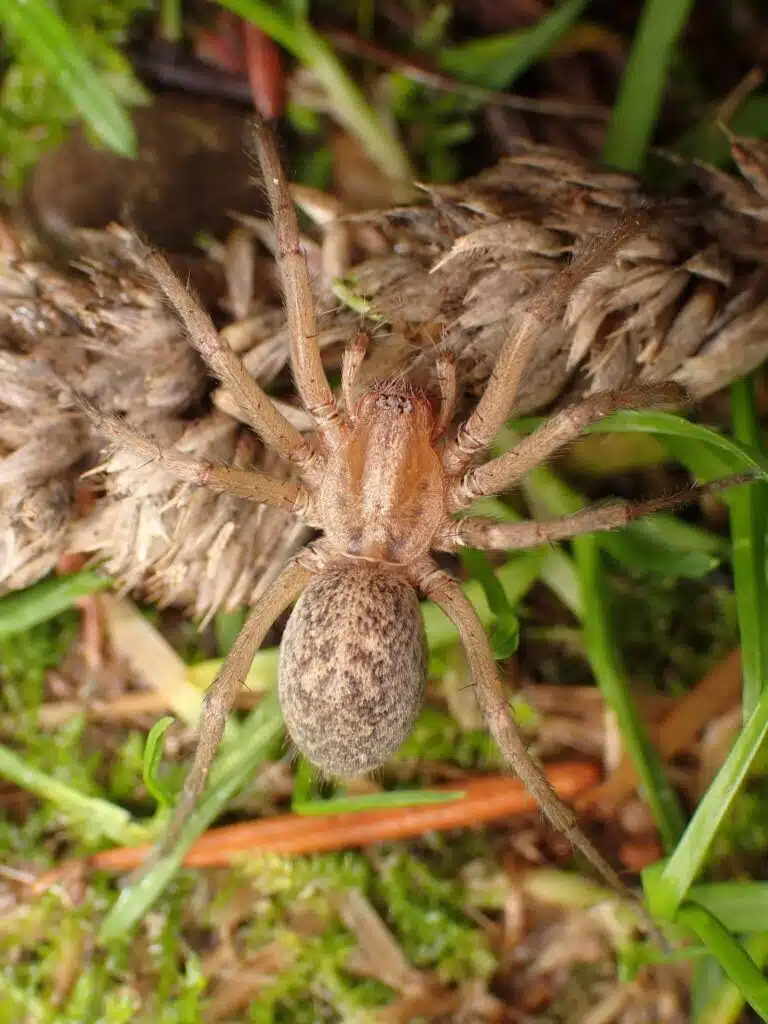
Scientific name: Eratigena agrestis
Common name: Hobo spider
Hobo spiders have a brown color and they grow to a maximum size of between 7 and 14mm.
These spiders build spider webs around homes, garages, barns, and wood piles.
Hobo spiders are now seen as non-venomous. However, some reports state the bite of this spider caused necrosis.
While its potential venomous bite is still debated, this spider is known to live in large areas in open fields in Northwestern US.
The spider is rarely seen indoors as other species such as the Common House spider is a predators of Hobo spiders.
6. Cross Orbweaver
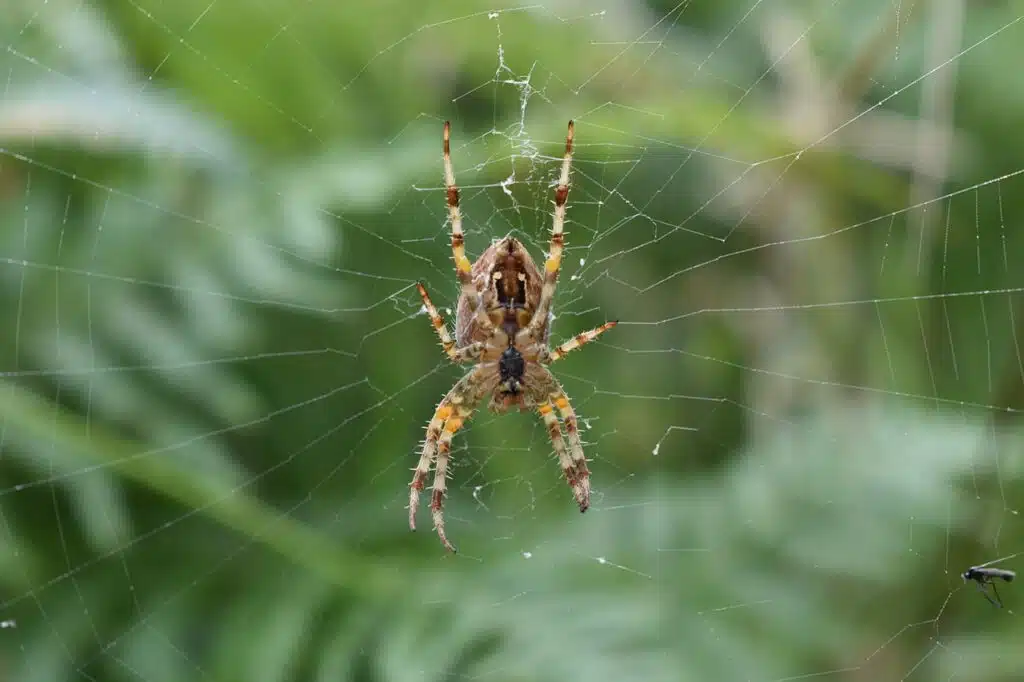
Scientific name: Araneus diadematus
Common name: Cross Orbweaver, European garden spider, diadem spider, orangie, cross spider, crowned orb weaver, pumpkin spider
Cross Orbweavers come in different colors. They have a base brown and white color and a common orange and brown color.
These spiders have brown marks on the abdomen and dark bands on the legs.
Cross Orbweavers build large spider webs used to catch insects and protect themselves.
They can sometimes catch and eat large insects, depending on their age.
These spiders also vibrate the spider web whenever a threat lands on it.
Cross Orbweavers have a cannibalistic nature as females eat mares while mating or after mating. Some females might even eat males before mating.
These spiders are also aggressive towards humans. They always bite when handled roughly.
Cross Orbweavers are common in the US and Canada. Its range expands across Europe as well.
7. Rabid Wolf Spider
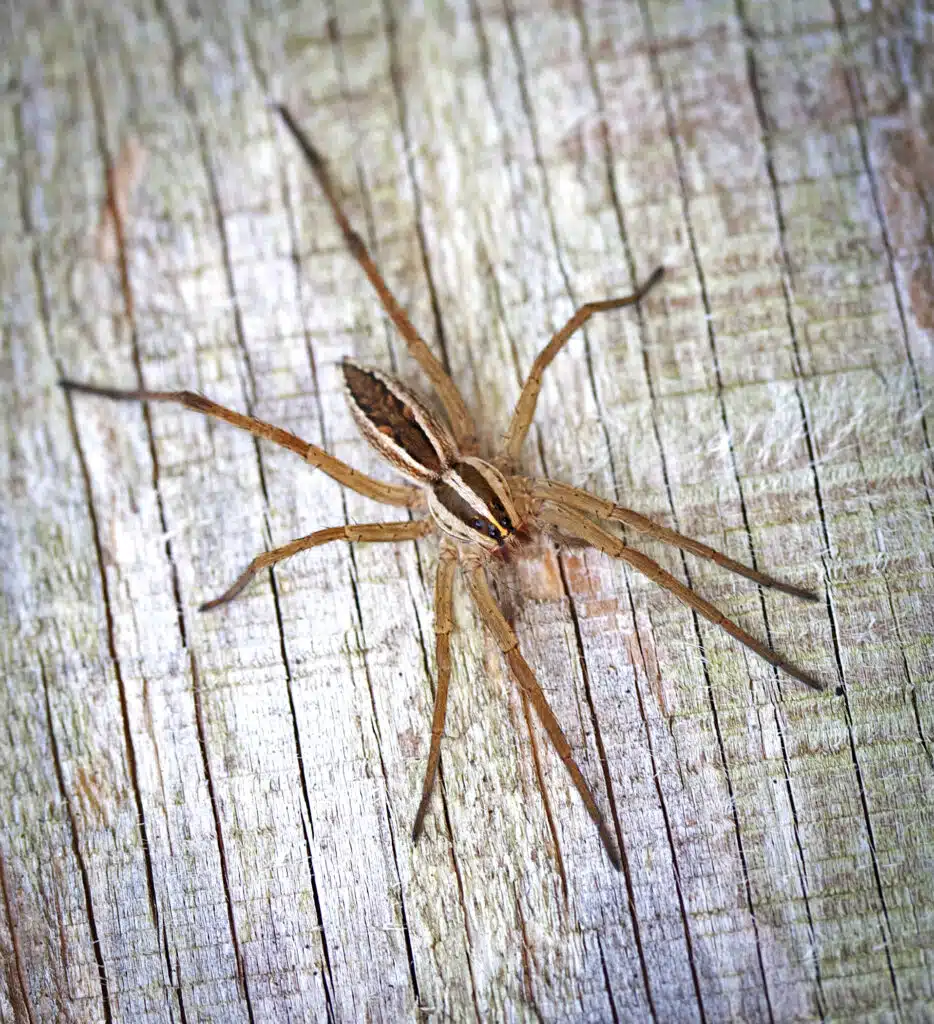
Scientific name: Rabidosa rabida
Common name: Rabid wolf spider
Once the wide central brown line is distinguished on the abdomen of the Rabid Wolf spider.
2 similar brown lines are seen on its cephalothorax. These dark brown lines are bordered by light brown lines.
The legs of this species are light brown.
Active at night, these spiders are hunters and they come out looking for prey to pounce on.
You can find Rabid Wolf spiders using a flashlight. The eyes of these spiders reflect the light of the flashlight unlike with many other spiders.
While not venomous, Rabid Wold spiders should be avoided. Their aggressive nature is what drives them to a painful bite.
8. Brown Widow
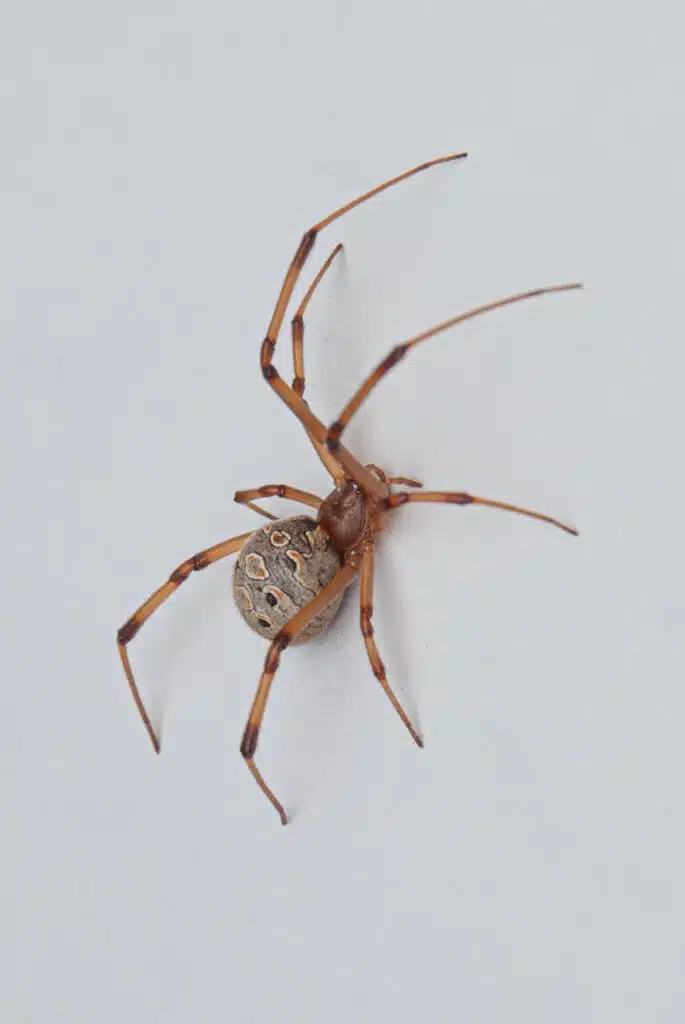
Scientific name: Latrodectus geometricus
Common name: Brown widow, brown button spider, grey widow, brown black widow, house button spider, geometric button spider
Brown Widows are part of the same group of spiders as Black Widows.
These venomous spiders have a brown and black body which changes in color as these spiders mature.
Some Brown Widow spiders might also exhibit an orange hourglass shape mark on the abdomen as opposed to a red mark on Black Widows.
Brown Widows have a toxic venom but are perceived as less threatening compared to Black Widows.
The bite of Brown Widows is less threatening than the bite of Black Widows since they only inject a smaller amount of venom.
Commonly found behind furniture or in areas that are hard to reach when in homes, this spider prefers thick vegetation to move along quicker.
This spider is well documented in Southern California. It’s not present in the Northern parts of the state but it’s believed to be expanding its range towards the central areas of the state.
9. Triangulate Combfoot
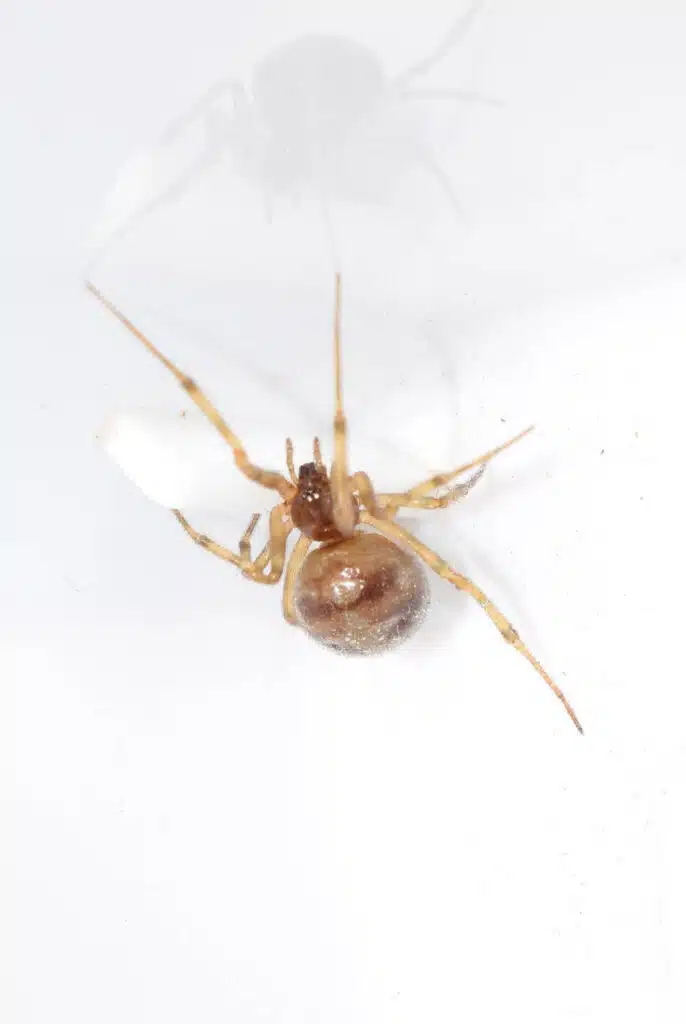
Scientific name: Steatoda triangulosa
Common name: Triangulate combfoot, triangulate cobweb spider, triangulate bud spider
As its name implies, this spider species has triangle-shaped markings on its abdomen.
These brown marks stand out on its dark body. The legs of the species have brown and black colors.
Triangulate spiders have a growing range in the US.
While not a species known to be purely beneficial, Triangulate spiders have a beneficial role as they eat many dangerous spiders and insects.
Triangulate Combfoot spiders hunt Brown Recluses. They also eat ticks and pillbugs meaning they can have a positive impact in the garden and around the house.
Spiders of this genus also commonly feed on ants. They are known to eat all types of ants and including Fire Ants.
10. Furrow Orbweaver
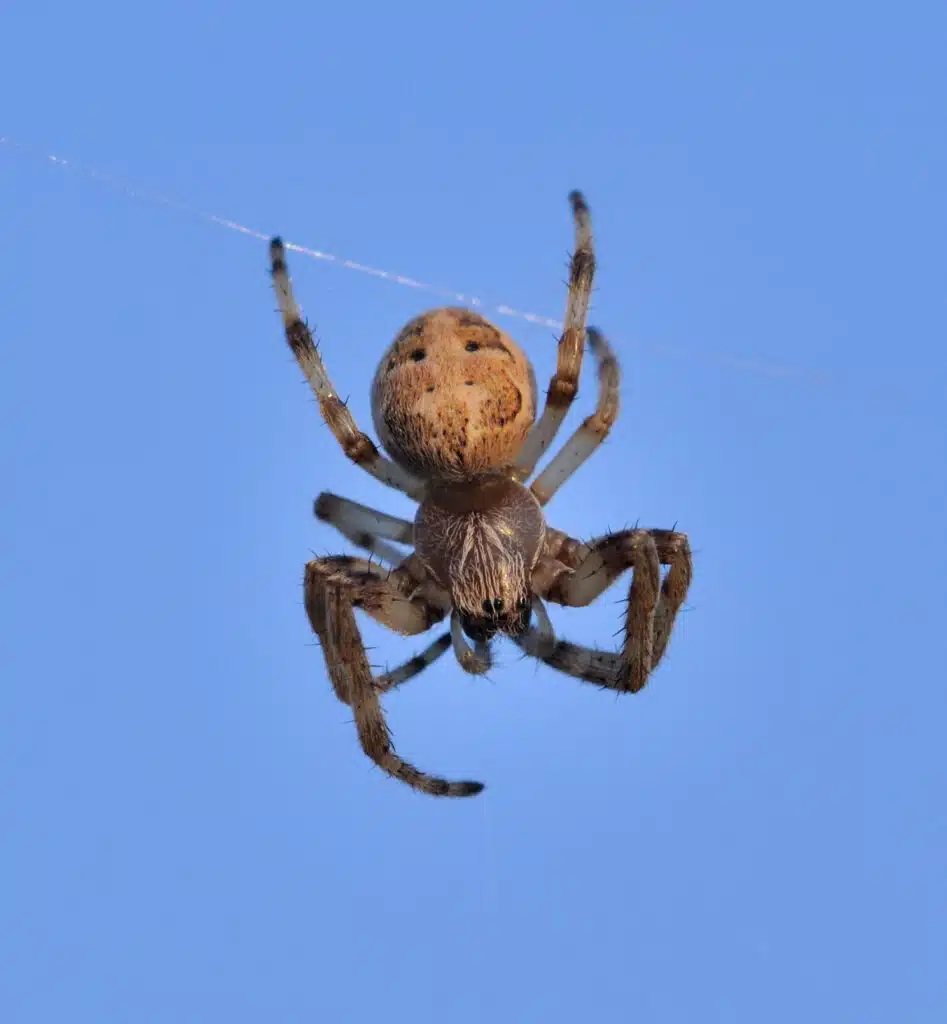
Scientific name: Larinioides cornutus
Common name: Furrow orbweaver, furrow spider, furrow orb spider, foliate spider
Furrow Orbweavers are brown spiders found next to the water. These spiders come in various colors and include a brown and yellow morph and a common brown and pink morph.
These spiders are common next to rivers, ponds, and lakes.
It builds large orb-shaped spider webs.
The spider web is repaired at the end of each day. Furrow Orbweavers are normally hiding nearby as they don’t expose themselves to spider webs.
11. Noble False Widow
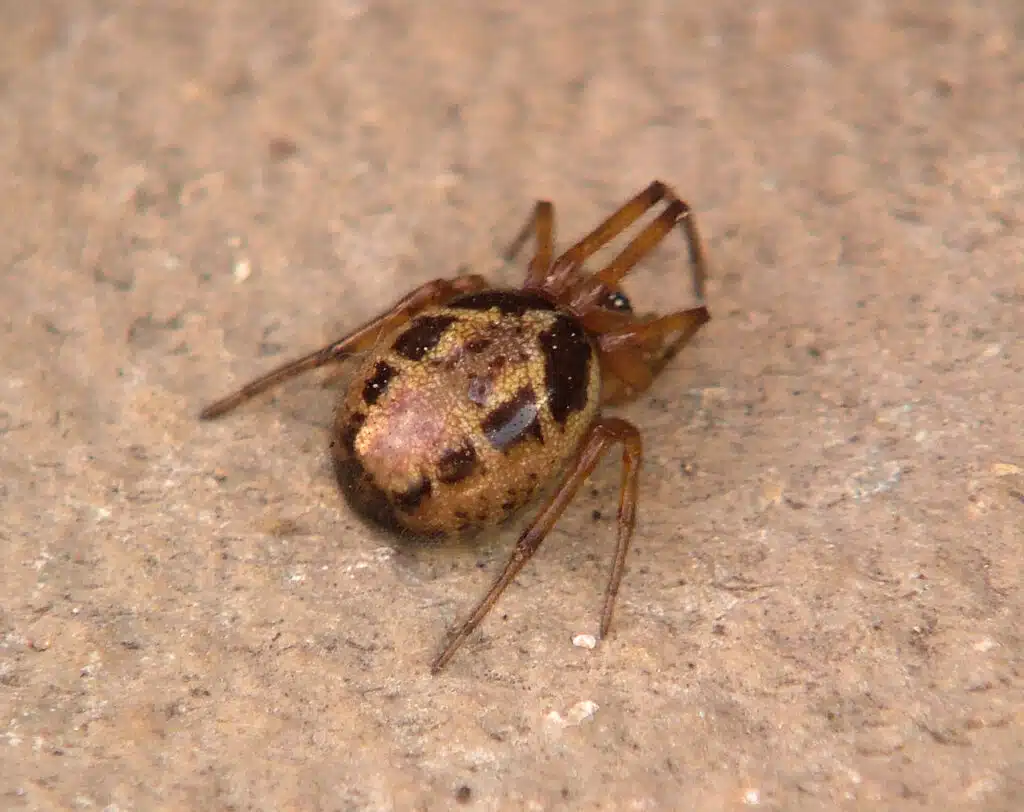
Scientific name: Steatoda nobilis
Common name: Noble false widow
Noble False Widows have a brown shiny body. They have dark brown legs, a brown to black cephalothorax, and a light brown abdomen.
These venomous spiders are known for eating all types of prey given their venomous bites. They have been seen eating small bats and even woodlice.
These spiders are known for their venomous bite. They are often seen as the most venomous species in Europe and as one of the most venomous species in North America.
High levels of pain are among the first symptoms following its bite. Noble False Widow bites pain levels are often compared to those of a large wasp.
Prolonged pain is another bite symptom. You can feel pain in the area of the bite for hours after the Noble False Widow bites, unlike with many non-venomous spider bites.
12. Texas Brown Tarantula
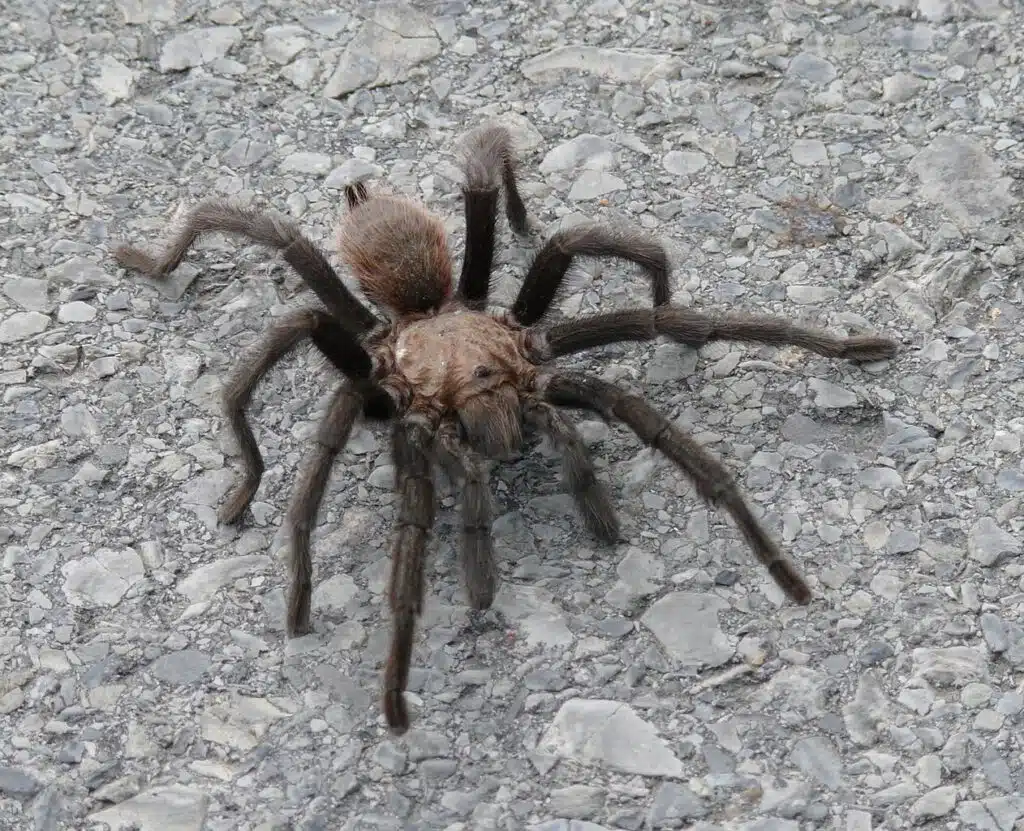
Scientific name: Aphonopelma hentzi
Common name: Texas brown tarantula, Oklahoma brown tarantula, Missouri tarantula
The Texas Brown Tarantula is one of the largest brown tarantulas in the South.
As its name implies, it can be found in Texas but also in nearby states such as Alabama and Louisiana.
This tarantula had light brown and dark brown coloring. Its hairy body is also known for having light brown and dark brown legs.
Growing to a length of about 6 inches, these tarantulas often blend in with the arid habitats they live in based on their shades of the brown body.
The Texas Brown Tarantula lines the entrance to its nest so that it senses movement as quickly as possible. This also helps it catch various prey.
This species lives in grasslands and it burrows in an underground nest to protect itself from high heat and potential predators.
13. Arabesque Orbweaver
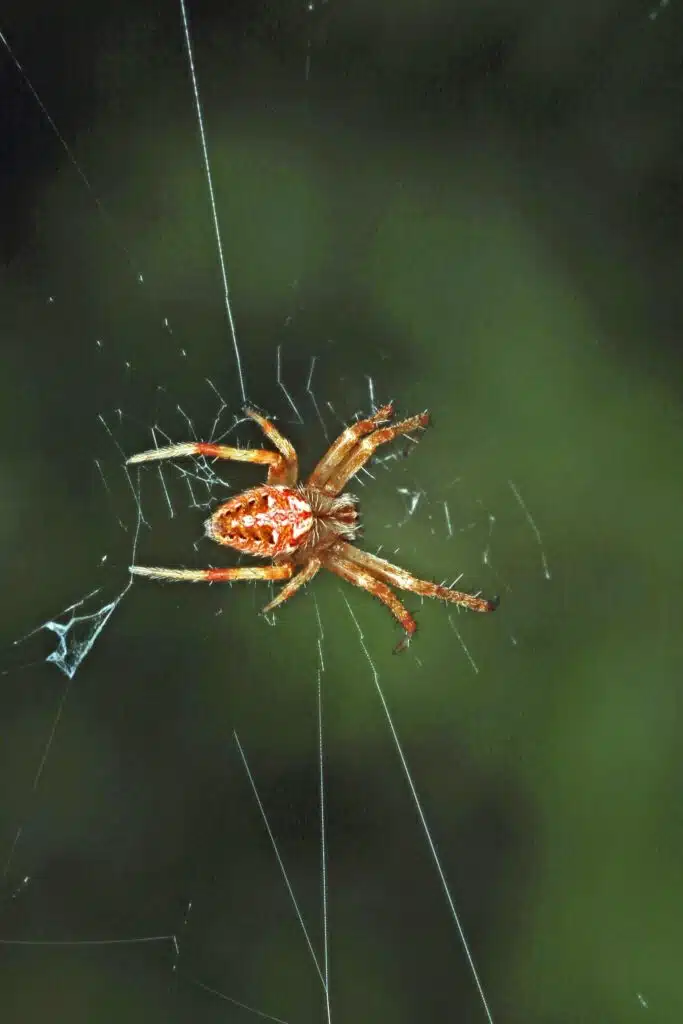
Scientific name: Neoscona arabesca
Common name: Arabesque orbweaver
The Arabesque Orbweaver is one of the multiple brown orbweaver spiders living in North America.
Like other orbweavers, it comes in multiple colors. A common color includes brown marks on the abdomen, typically in the form or lateral bands of a central yellow section.
The cephalothorax of the species can be light brown, orange, or rust-orange.
Many morphs of this species have light brown legs.
These spiders are rarely seen as they prefer to hide. Female Arabesque Orbweavers make large spider webs but they prefer to hide nearby.
You can typically discover the female behind a leaf next to the spider web.
Males are rarely seen and mostly seek out females for reproduction.
14. White-banded Fishing Spider
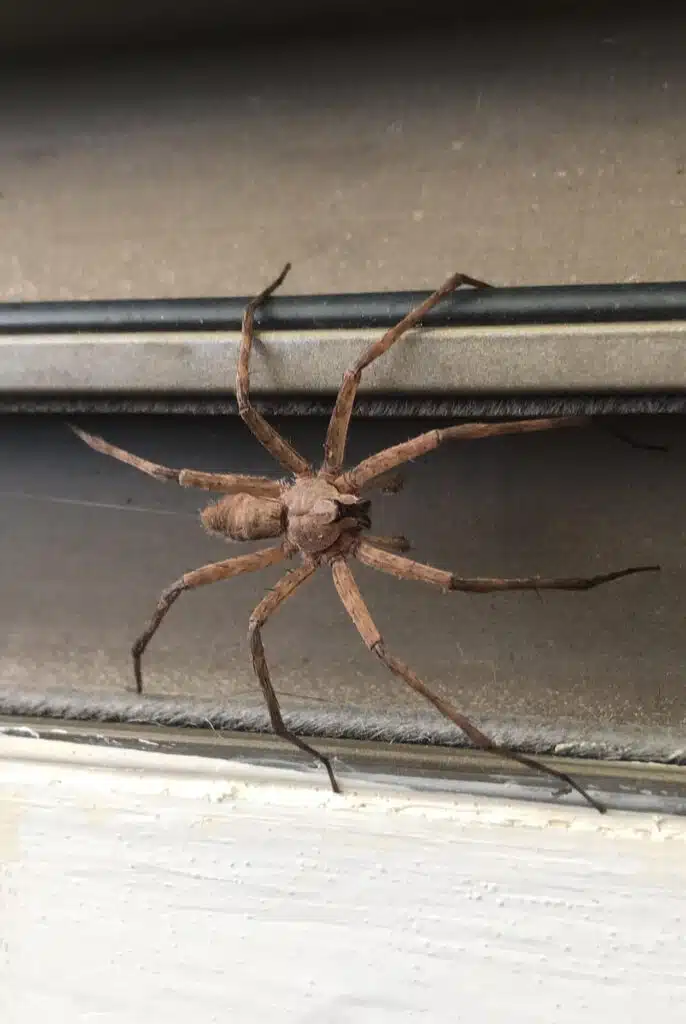
Scientific name: Dolomedes albineus
Common name: White-banded fishing spider
The main color of the White-banded Fishing spider can be green or gray. White marks are also common.
Spiders of this genus also come with brown marks instead of white marks in multiple morphs. A green and brown morph of the White-banded Fishing spider is common.
The semi-aquatic habitat of this species is believed to influence its morphs the most.
This spider is also seen in rare morphs such as orange or rust, but these don’t come with brown marks.
The brown marks of this species cover its body and its legs.
While a fishing spider, the White-banded Fishing spider is still seen out of the water, often on tree trunks.
It constantly looks for food, mainly small insects that love water such as mosquitoes and flies.
15. Tigrosa annexa
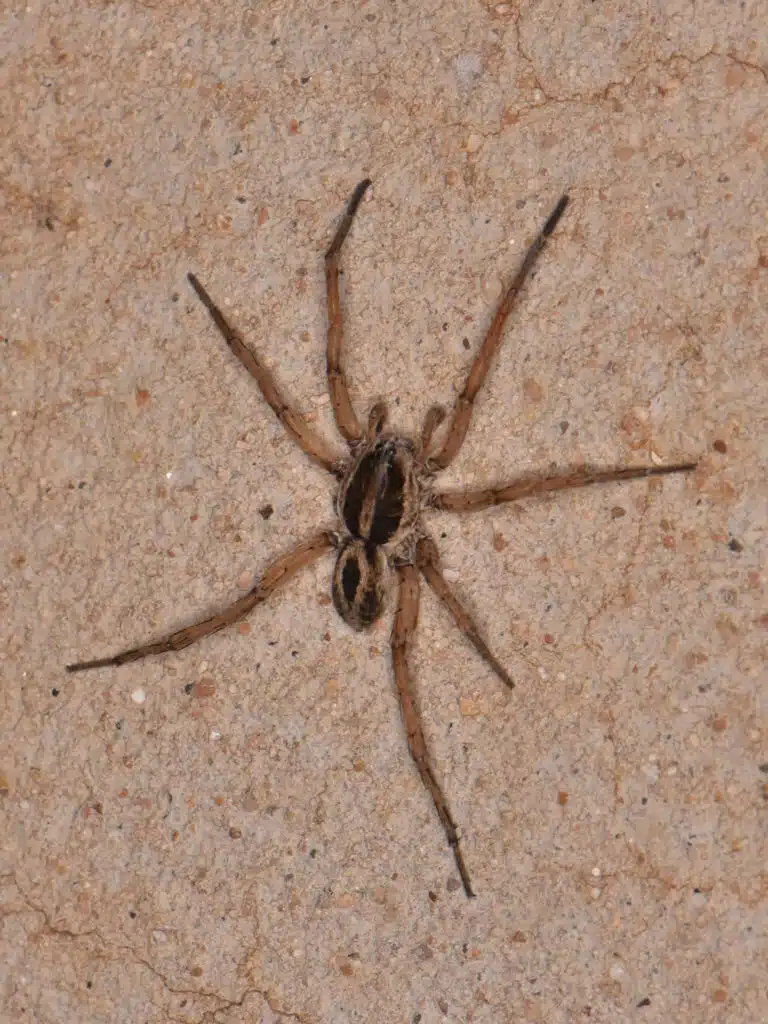
Scientific name: Tigrosa annexa
Common name: Tigrosa annexa
Trigroas annexa is a type of fishing spider with a green-brown body. This is the only species of fishing spider with a green hue across all of its morphs.
The brown color is also dominant. Wide dark brown bands are seen on its body. Light brown-green coloring is also seen on the abdomen and the hairy legs of the species.
The contrasting light brown to the dark brown body makes this species resemble wolf spiders.
A small number of Tigrossa anexa spiders have these colors as they prefer drier habitats. They might even be seen on sandy habitats.
Many spiders that live on sand have similar molted colors.
This spider is an active hunter. Once believed to be a burrower, Tigrosa annexa moves on the ground to find its next insect meal.
16. Asiatic Wall Jumping Spider
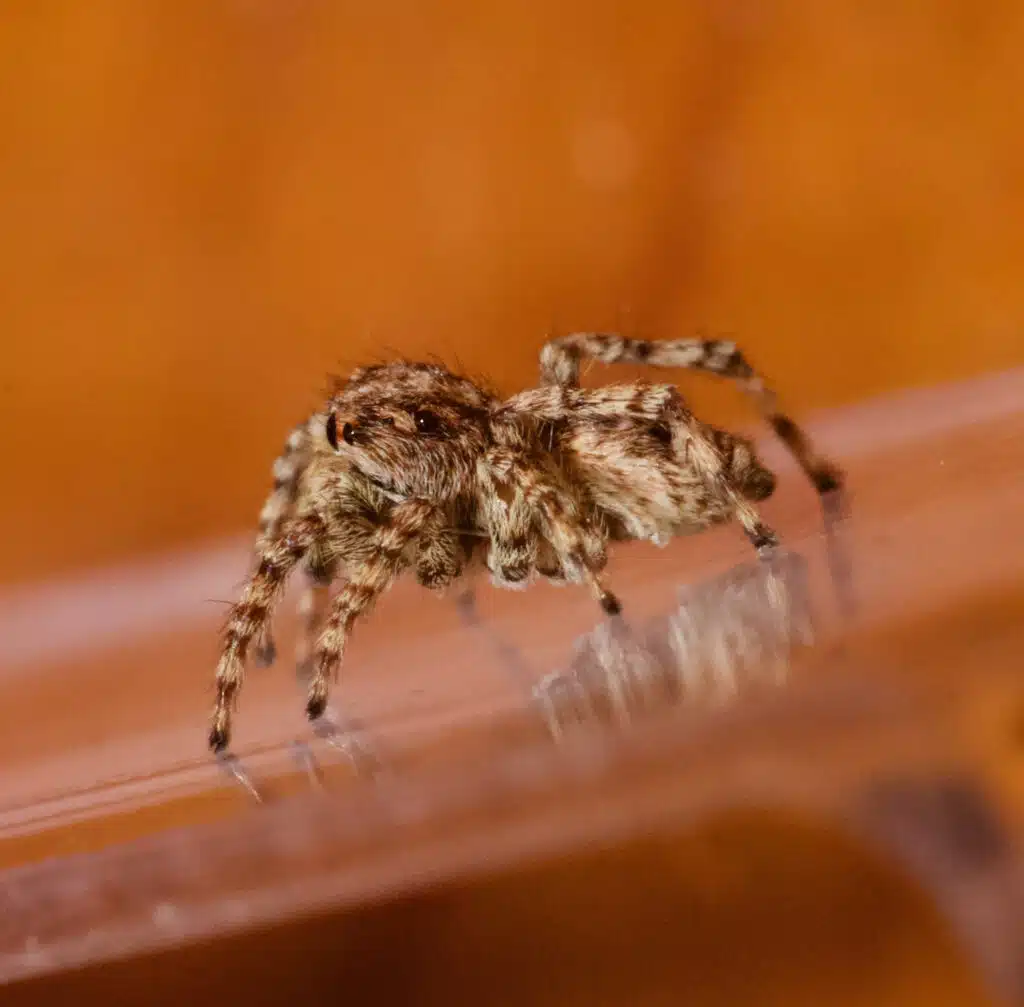
Scientific name: Attulus fasciger
Common name: Asiatic wall jumping spider
Asiatic Wall Jumping spiders are mostly brown, but also black and white.
These spiders feature light brown and dark brown coloring in the form of marks with black and white bordering.
Almost chevron-like, the marks are mostly visible on its larger abdomen.
Its legs have brown, black, and white bands.
The cephalothorax of the species has the same brown, black, and white coloring with black marks on the lower side.
These spiders are smaller than the average brown North American species.
Females grow to 5-6mm while males grow to 4-5mm.,
Most Asiatic Wall Jumping spiders are seen on the outer walls of homes.
They tend to move along towards lights at night as these lights attract flies they eat.
Spiders of the genus remain active around homes until mid-fall.
17. Bowl-and-doily Spider
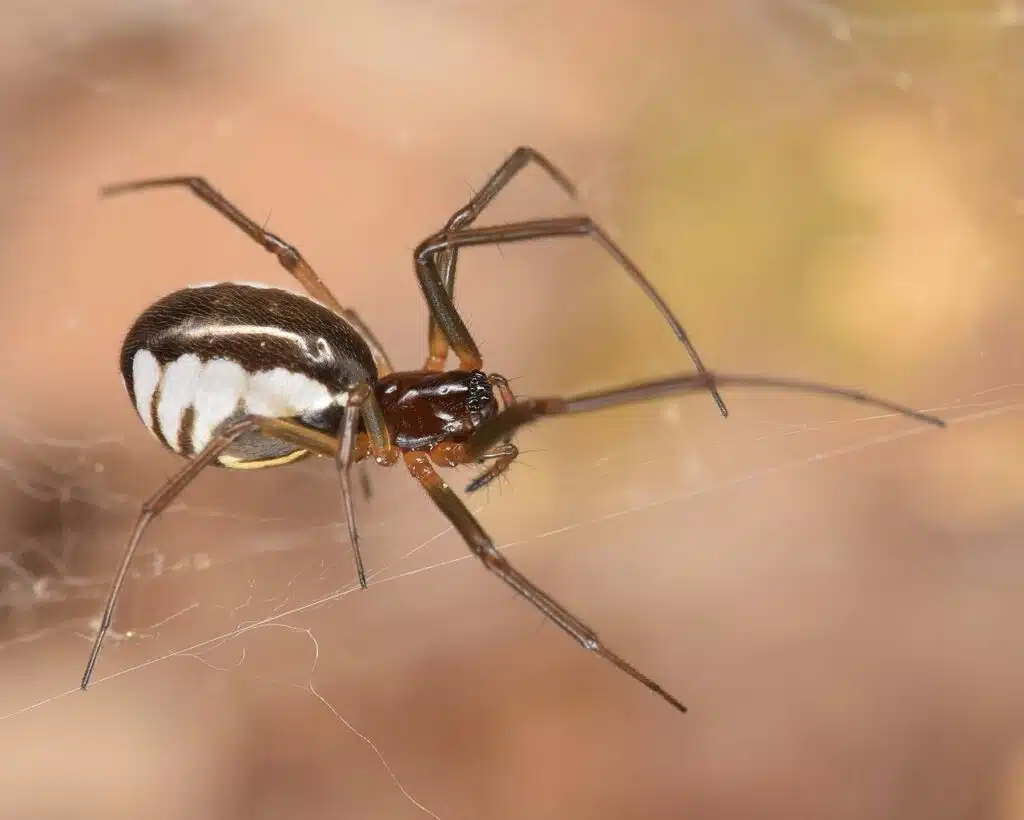
Scientific name: Frontinella pyramitela
Common name: Bowl-and-doily spider
This spider species has a mostly brown or red-brown color with 2 lateral white bands on the abdomen.
Spiders of this genus are mostly known for creating different and uniquely-shaped spider webs.
One of these shapes is a bowl.
Spiders place themselves in the center of the bowl-shaped spider web and await for insects to come inside.
They quickly snatch the insect even before it lands on the spider web and inject paralyzing venom into it.
Bowl-and-doily brown spiders are known for having an excellent memory. They can hide their prey in an area and come back to consume it later.
Male spiders exhibit no web-building skills. They also show more white coloring on the abdomen compared to females.
Males have multiple white stripes on the abdomen while females only have 2 wide bands on the abdomen.
18. Western Lynx Spider

Scientific name: Oxyopes scalaris
Common name: Western lynx spider
The Western Lynx spider is one of the few brown species with thick sharp bristles.
These bristles have a black color and they can assist the spider in catching insects easier.
Some believe the bristles of the Western Lynx spider are mostly tied to its defensive capacity as many predators turn away from the spider when seeing its sharp bristles.
The spider itself is dominated by brown coloring. It has a light brown abdomen with yellow or white irregular marks.
Its cephalothorax is also light brown but it also has black and white marks appearing somewhat darker.
The legs of the species have light brown, dark brown, and black marks and bands.
They are dominated by black bristle-like hairs.
Based on their excellent vision, these spiders catch prey by jumping or ambushing it.
19. Tropical Orbweaver
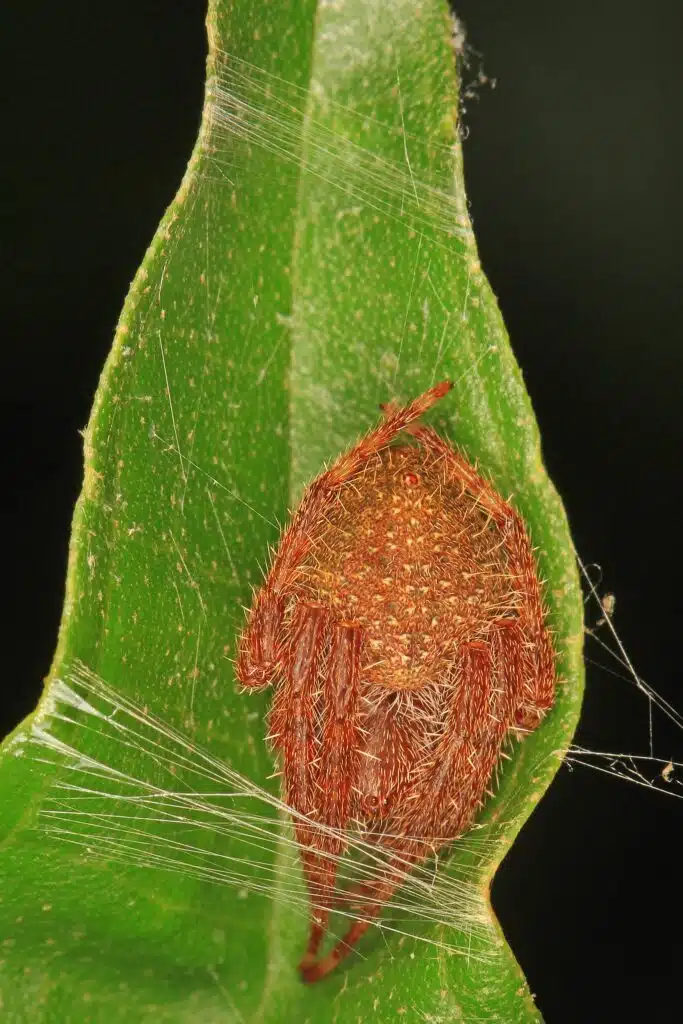
Scientific name: Eriophora ravilla
Common name: Tropical orbweaver
Tropical Orweavers are common brown spiders in coastal regions.
Spiders of the family come in different colors but are mostly brown in Florida.
Subtle color differences are visible between males and females, mostly on the abdomen.
The female has off-white marks on the abdomen while males can have an almost completely neon-green abdomen.
Both males and females are brown in Florida (pink or red in other states).
The male has dark brown coloring with red-brown legs.
Females have a uniform brown color with white or light brown hair.
These hairs cover both its body and its legs.
The female of the species is further identified by a group of white marks or off-white marks in the form of dots on the abdomen.
These dots are both large and small but the largest light marks on the abdomen of the female have an irregular shape.
20. Wetland Giant Wolf Spider
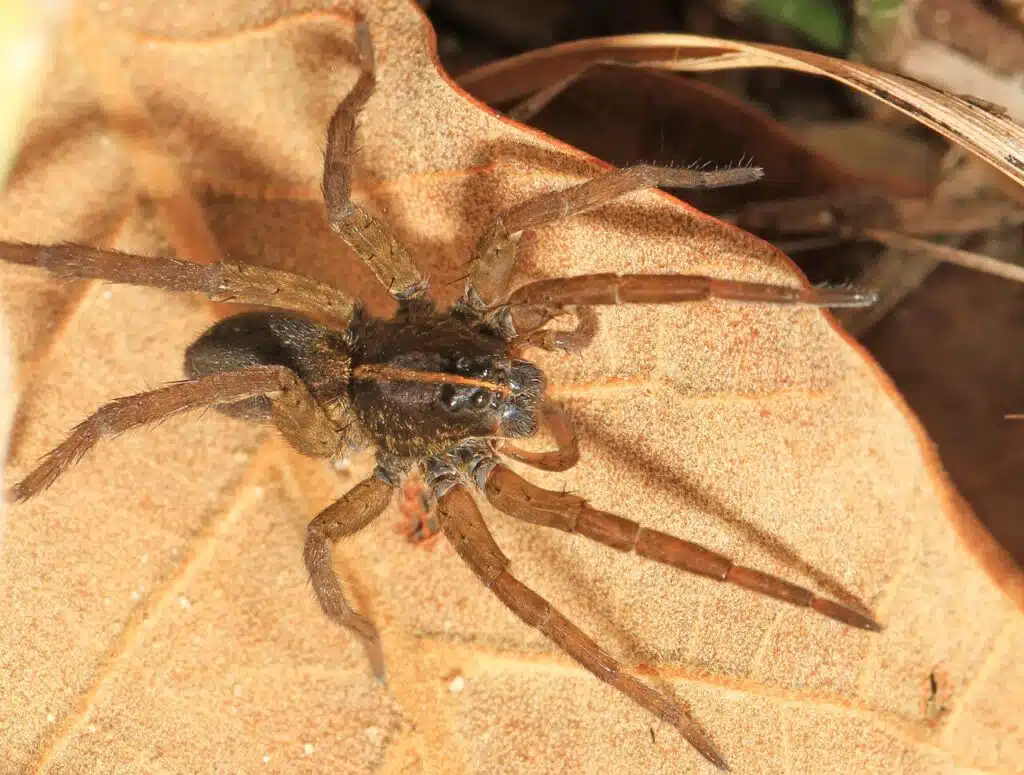
Scientific name: Tigrosa helluo
Common name: Wetland giant wolf spider
Brown, black, and yellow are the main colors of this spider. Wetland Giant Wolf spiders have a dominant brown or brown-green color.
The green undertone of the species can be influenced by its preference for marshes and habitats with plenty of vegetation.
The black marks on the species are seen in the form of fine lines that lead towards a central yellow stripe.
The legs of these spiders are mostly brown but they can appear rusty-brown in some spiders.
Wetland Giant Wolf spiders are active hunters.
They only come out at night looking for typical prey in marshes such as insects or smaller spiders and their larvae.
The reproductive cycle of the species is dominated by the female.
Female Wetland Giant Wolf spiders are larger than males. They also live longer as they can survive up to 2 years.
21. Garden Ghost Spider
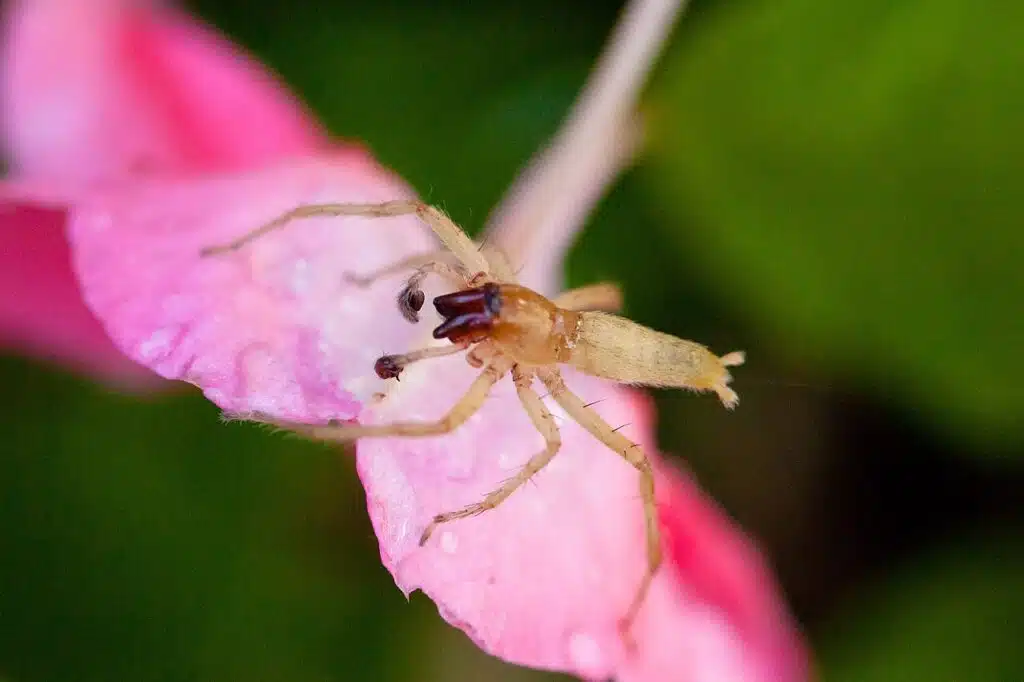
Scientific name: Hibana gracilis
Common name: Garden ghost spider
Growing to about half an inch, Garden Ghost spiders are among the brown spiders that can be found in homes.
These spiders are attracted to light when moving indoors from the garden.
They have an almost completely-brown body. These spiders have a light brown abdomen with dark brown markings in their central position.
Yellow-brown or pale yellow are the main colors of the cephalothorax.
Spiders of the genus have dark brown legs or light brown legs.
These spiders hide during the day. They prefer to use their silk to create small shelters or retreats to hide in during the day.
But these spiders might also hide under objects or vegetation without building a silken nest every day.
They only come out at night. These spiders don’t build spider webs for food as they hunt insects by ambushing them.
Highly common in the summer, these spiders are very active around the year in warm climates.
As a result, they can be seen throughout the year in Florida and Texas.
22. South American Toothed Hacklemesh Weaver
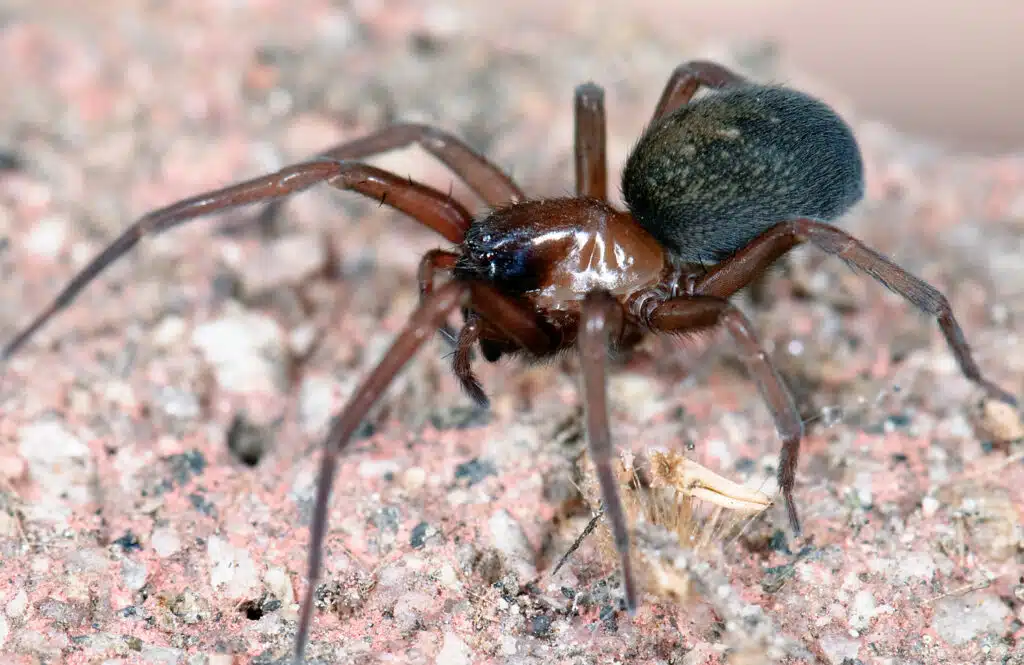
Scientific name: Metaltella simoni
Common name: South American toothed hacklemesh weaver
This brown spider has been introduced to the US accidentally as it’s native to South America.
It has traveled a long journey to reach the US from Argentina and nearby countries.
Already established in the US for a few decades, the South American Toothed Hacklemess Weaver is a brown spider.
There are differences in the shade of brown and overall appearance between females and males of the species.
Females appear larger. They have a dark brown cephalothorax and legs while the abdomen is mostly uniform black without any marks.
Male spiders have a light brown color and they might also show yellow marks on the abdomen.
Growing to an average size of around 8mm, these spiders are now common in Florida and California.
They have been first seen in Louisiana and Florida where they prefer to hide under rocks and logs during the day,
23. Mouse Spider
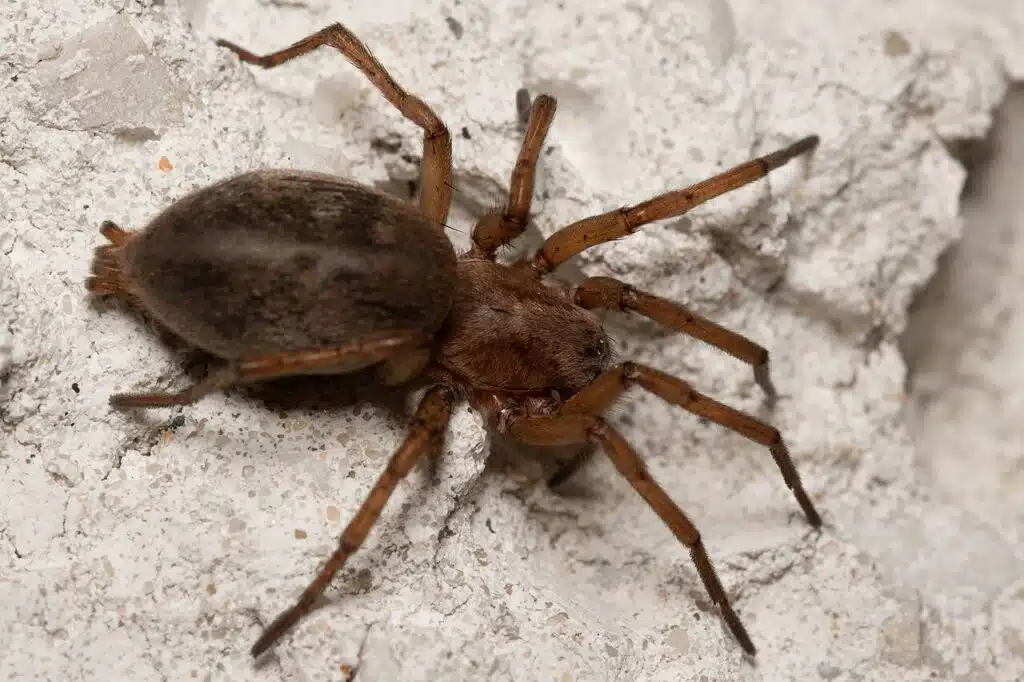
Scientific name: Scotophaeus blackwalli
Common name: Mouse spider
The Mouse spider is one of the common brown species in homes.
Found in North America and Europe, this spider species gets its name from its resemblance to mice.
It’s the abdomen of the species that has a mouse gray color while the rest of the body has a shiny brown color.
Its legs are also dark brown.
These spiders are known to grow to 12mm in the case of females and 8mm in the case of males.
They live indoors if they can find sufficient insects to feed on but can also live outdoors during the summer.
Mouse spiders move indoors in temperate climates for warmth. They can only survive winters indoors.
The species is mostly nocturnal and you might not see it indoors during the day as it hides until nightfall.
24. Broad-Faced Sac Spider
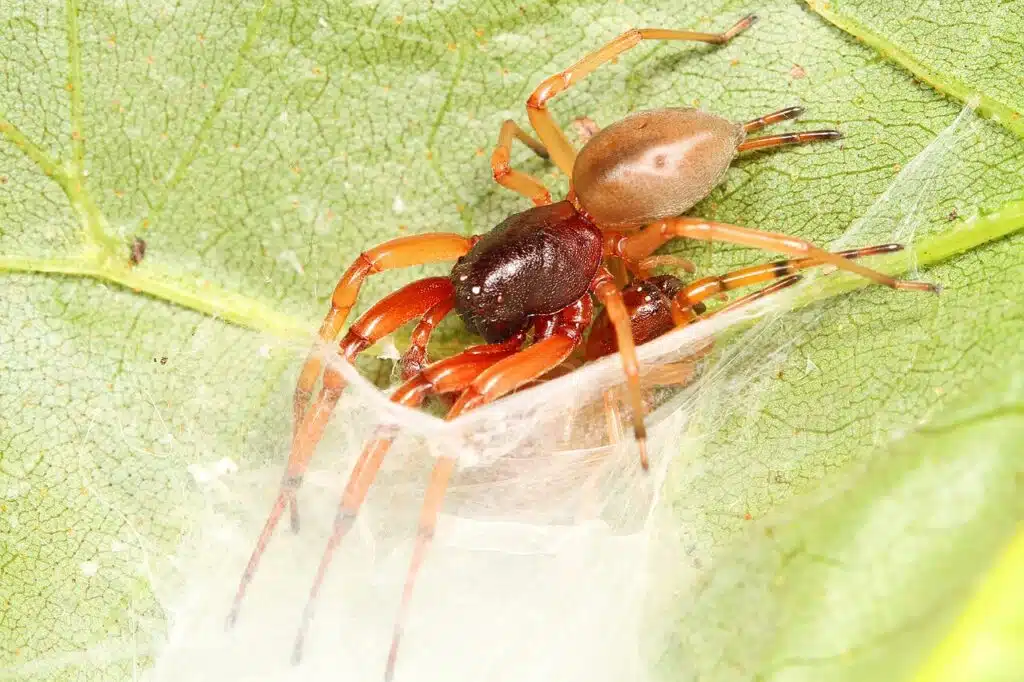
Scientific name: Trachelas tranquillus
Common name: Broad-faced sac spider
Similar to Mouse spiders, Broad-Faced Sac spiders also have gray and brown coloring.
However, this species has a black cephalothorax. Its abdomen has a mouse-like gray color while its long legs and antennae are brown.
Some spiders of this genus have red-brown legs and antennae.
The female of the species is almost twice the size of the males.
Females grow to 10mm while males grow to 5-6mm.
Both males and females have small dents or puncture-like signs on the abdomen which can be seen easier on spiders with a light gray-yellow abdomen.
25. Giant Crab Spider
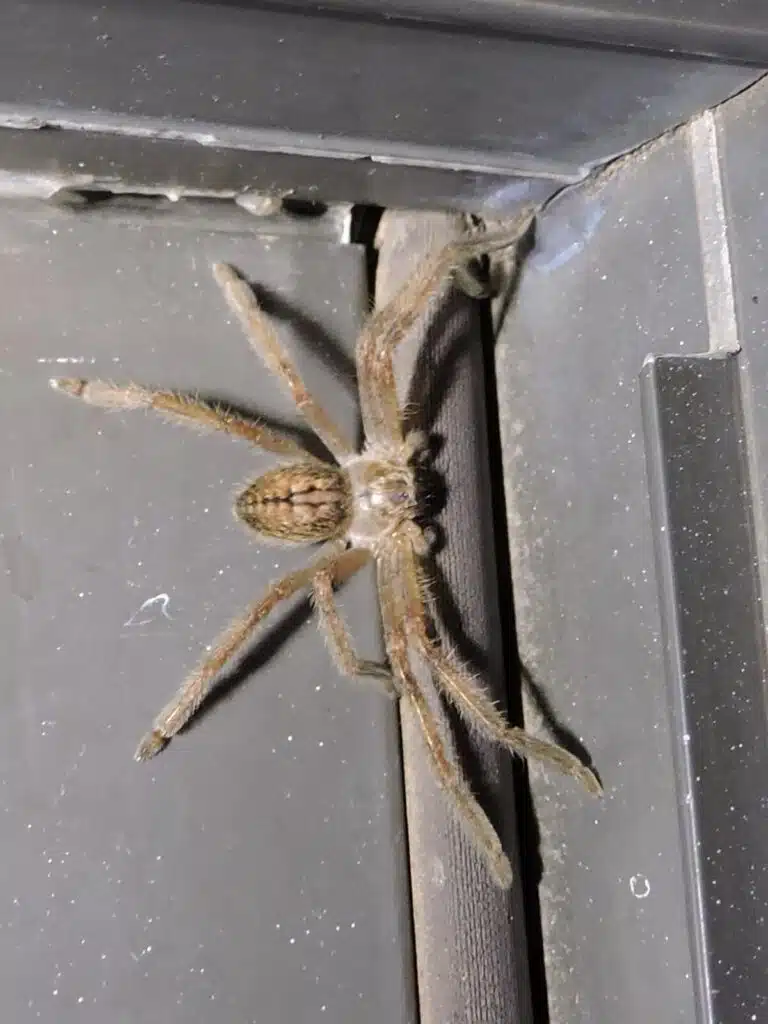
Scientific name: Olios giganteus
Common name: Giant crab spider
Giant Crab spiders are one of the largest brown species in the US.
This spider is commonly found in Arizona and the Sonoran Desert.
It has a brown color with a black stripe on the abdomen.
Giant Crab spiders are one of the few brown species where the abdomen is smaller than the cephalothorax.
Its very long legs allow this spider to move similarly to crabs.
These spiders can grow to more than 50mm and this means they can be potentially dangerous to people.
Its bite is highly painful, but not venomous.
26. Grey House Spider
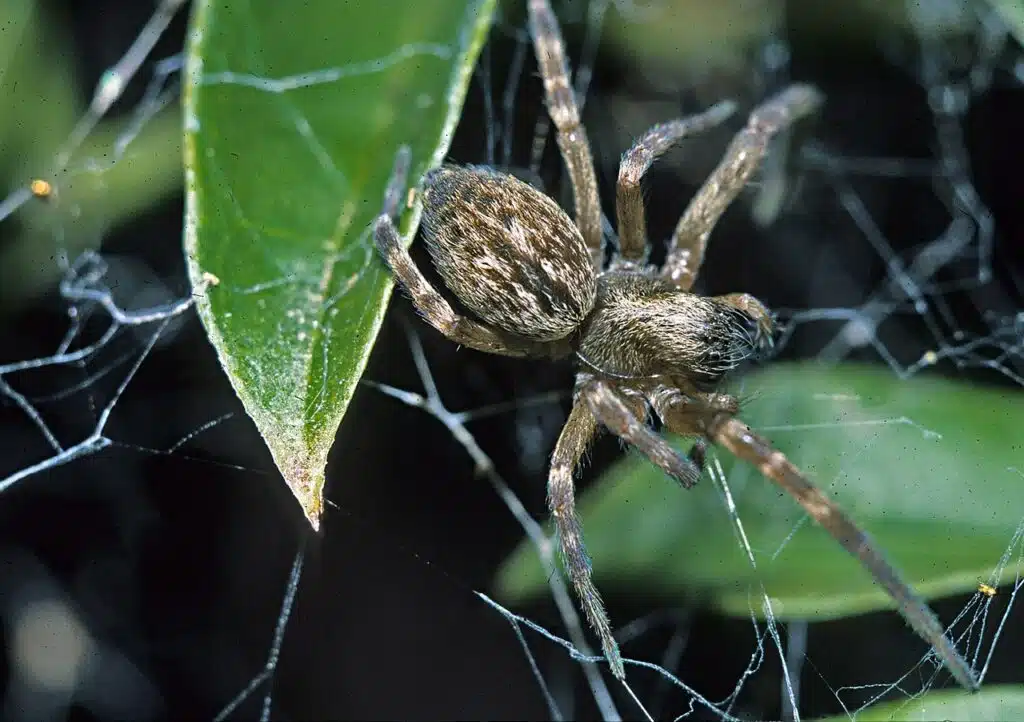
Scientific name: Badumna longinqua
Common name: Grey house spider
Grey House spiders are found indoors as they eat moths and ants that invade homes.
The spider species is known for having a hairy body.
Its body is dominated by black and white hairs with more black hairs on the edges.
Its legs are mostly brown with black bands.
Spiders of the genus are seen in quiet areas of the home. This includes basements and attics.
They build spider webs in the corners of these areas and they stay these preferring not to build spider webs in busy areas of a home such as the living room.
27. Cat-faced Orbweaver
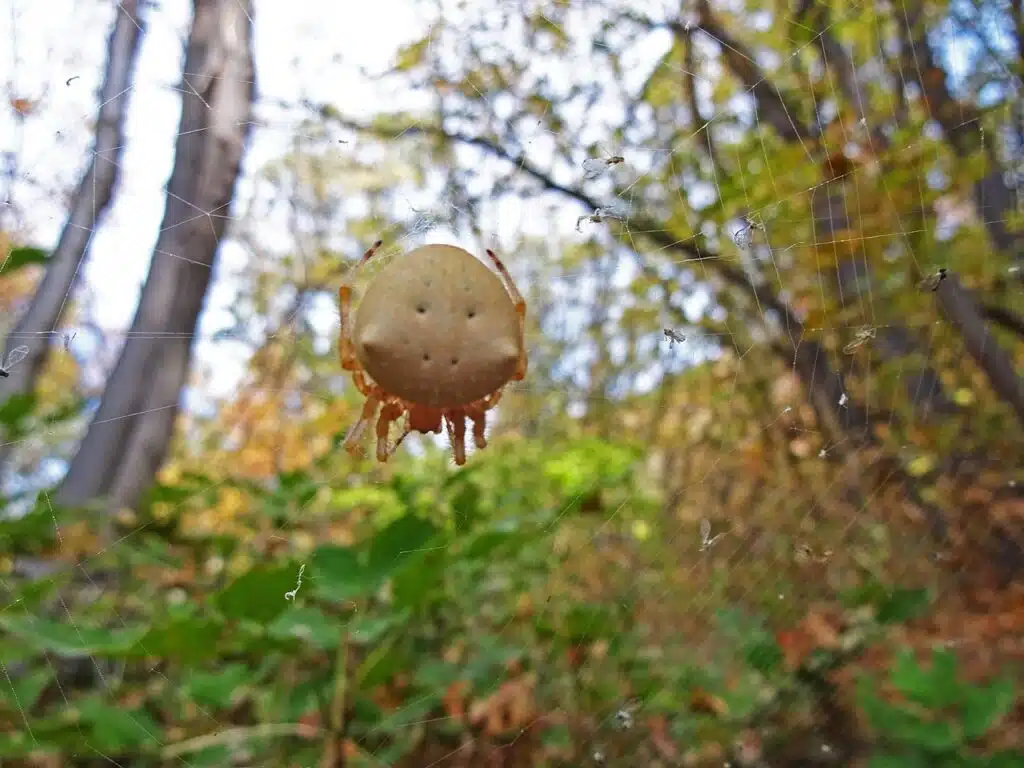
Scientific name: Araneus gemmoides
Common name: Cat-faced orbweaver, jewel spider
This spider has a tawny brown color and it builds spider webs in an orb form.
The spider has light brown coloring on the abdomen. Females have 2 black spots and black margins on the abdomen together with short white hairs.
The rest of the body has light brown and dark brown coloring.
Cat-faced Orbweavers have a light brown with dark red-brown band coloring on the legs.
Females also exhibit short white hairs on the legs, similar to those on the abdomen.
28. Starbellied Orbweaver
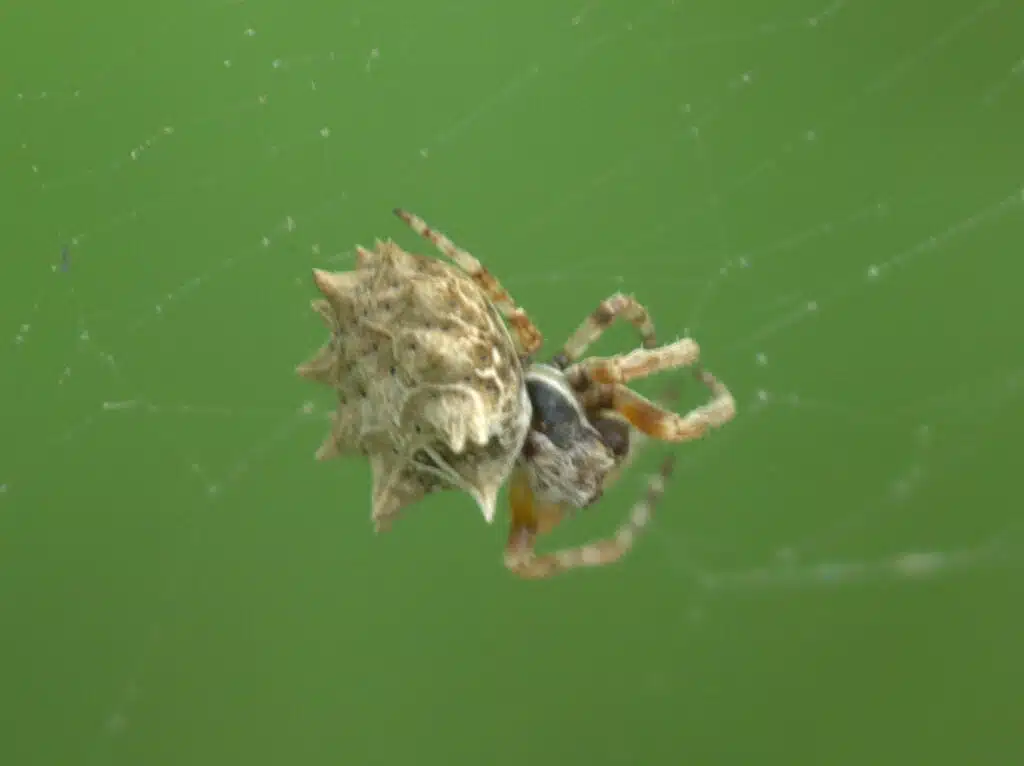
Scientific name: Acanthepeira stellata
Common name: Starbellied orbweaver, starbellied spider
The Starbellied Orbweaver is a species that is named after its abdomen shape.
Starbellied Orbweavers have an irregular shape abdomen with spines that resemble stars.
The coloring of the abdomen is gray-brown while the rest of the body is dark brown while its legs are bright brown.
This species has an expanding territory as it can be found both in North and Central America.
Spiders of this genus build orb-shaped spider webs in habitats close to coastlines.
29. Wall Spider
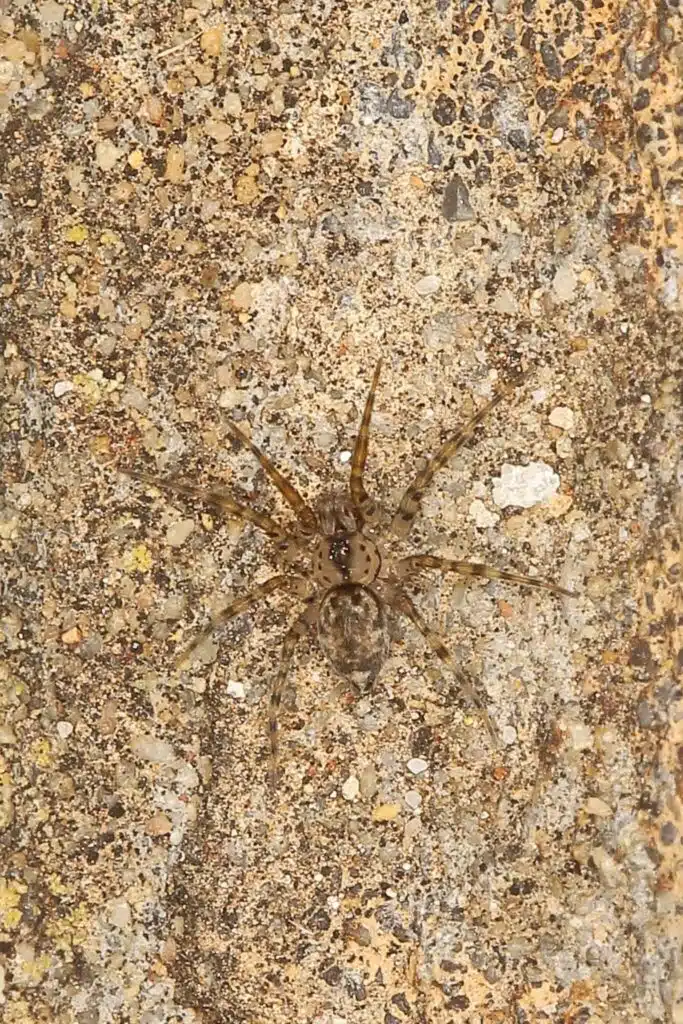
Scientific name: Oecobius navus
Common name: Wall spider
These spiders have white-gray legs and a brown-gray body.
As their name implies, they live on walls where they also look for insects.
These spiders make the most of wall cracks and crevices.
They cover these openings with a simple spider web so that they trap flying insects such as gnats and mosquitoes.
These spiders are non-aggressive and flee when seeing people.
30. Barn Funnel Weaver
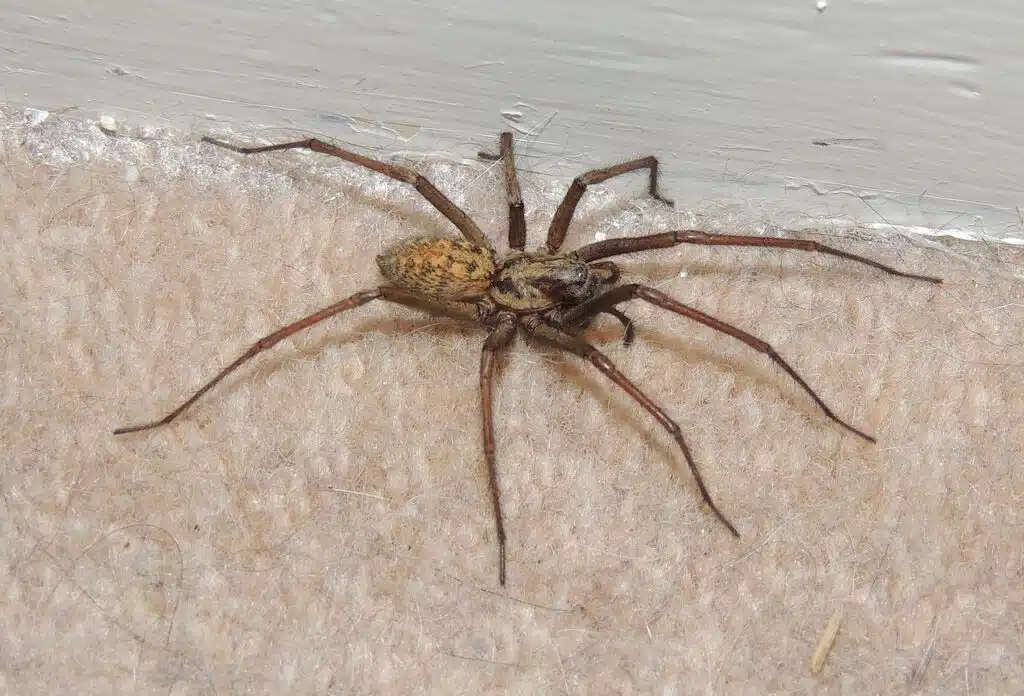
Scientific name: Tegenaria domestica
Common name: Barn funnel weaver, domestic house spider
These spiders are common on farms, which inspires their name.
The coloring of Barn Funnel Weavers is mainly brown and black.
Alternating brown and black bands are seen on its body and its legs.
Spiders of the genus have thin long legs which help them move very fast.
Barn Funnel Weavers can bite, but their bite isn’t venomous. Still, it’s best to avoid these spiders as their bite is still very painful.
31. Drumming Sword Wolf Spider
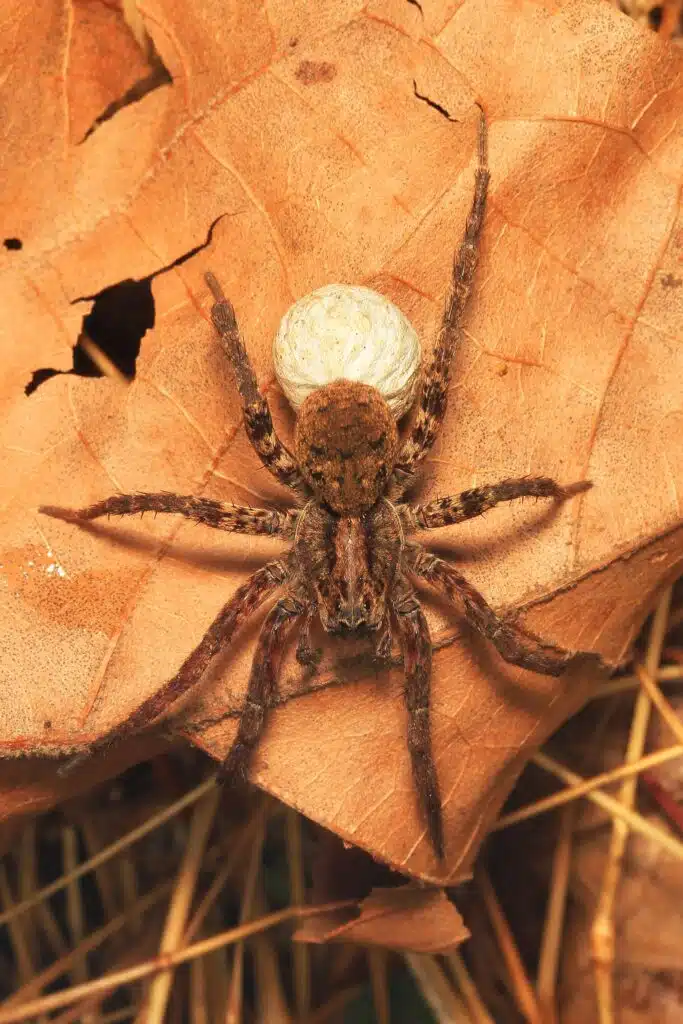
Scientific name: Gladicosa gulosa
Common name: Drumming sword wolf spider
The drumming Sword spider is one of the most common wolf spider species of brown color in North America.
These spiders have a background brown color with black marks, stripes, and bands.
The black marks on its body are barely visible by comparison to the wide black bands on its legs.
Spiders of this genus are nocturnal and difficult to spot during the day as they hide in brown ground-level leaves.
32. Mediterranean Spiny False Wolf Spider
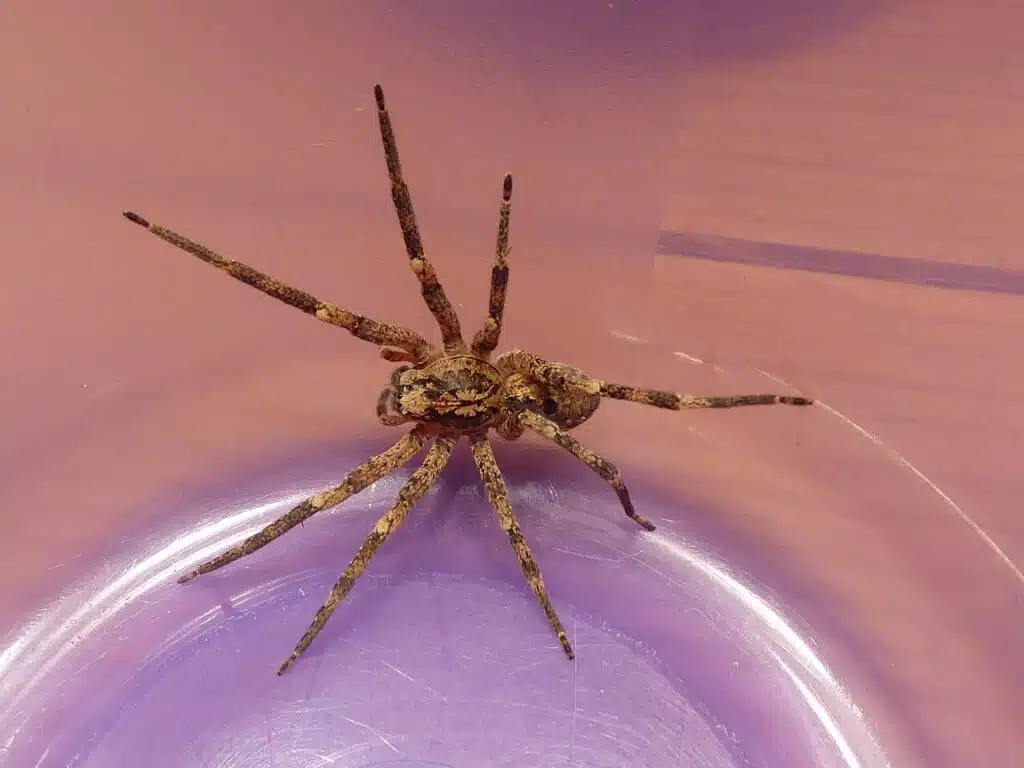
Scientific name: Zoropsis spinimana
Common name: Mediterranean spiny false wolf spider
These spiders have a dominant brown color on the elongated abdomen and cephalothorax.
Dark brown bands are seen behind its head.
Mediterranean Spiny False Wolf spiders have dark color bands to mimic true wolf spiders.
The bites of these spiders are very painful given their size. Their bite penetrates the skin and results in lasting pain.
33. Pantropical Huntsman Spider
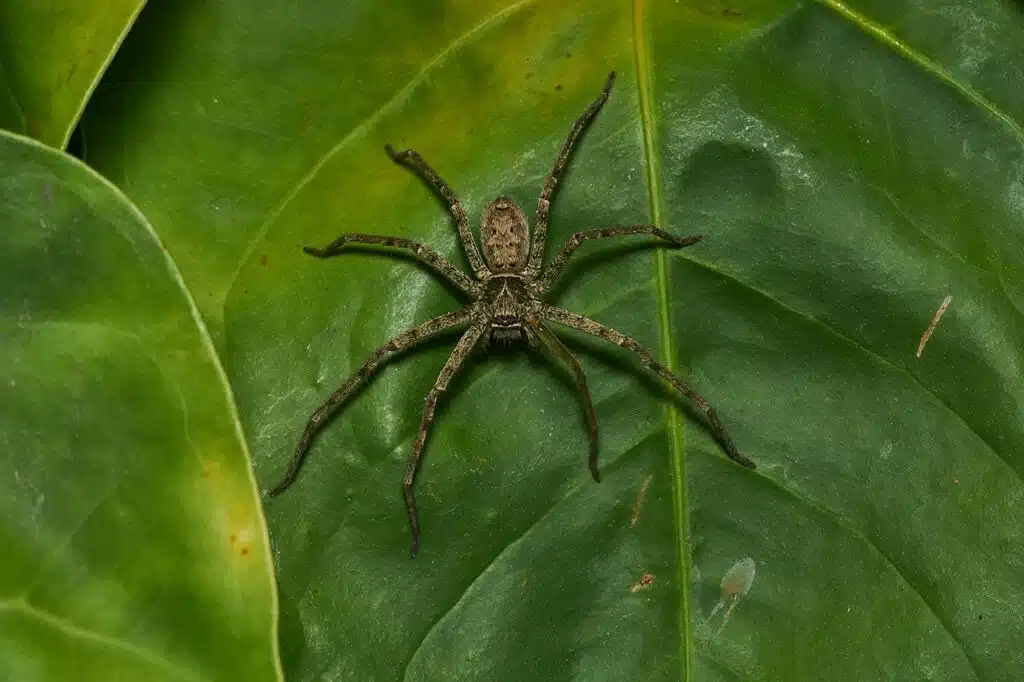
Scientific name: Heteropoda venatoria
Common name: Pantropical huntsman spider, giant crab spider, cane spider
Brown coloring and black marks are specific to the Pantropical Huntsman spider.
One of the most common assumptions about this species is incorrect since most people associate them with Brown Recluses.
However, Pantropical Huntsman spiders aren’t uniform brown as the feared Brown Recluse.
These spiders exhibit multiple black marks on the body and the legs.
The Pantropical Huntsman spider also has a flatter body which allows it to get indoors taking advantage of small cracks and wall openings.
Further Reading: